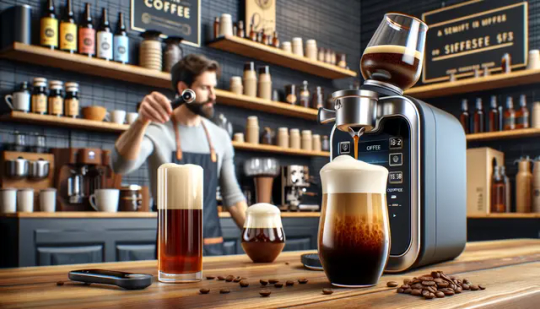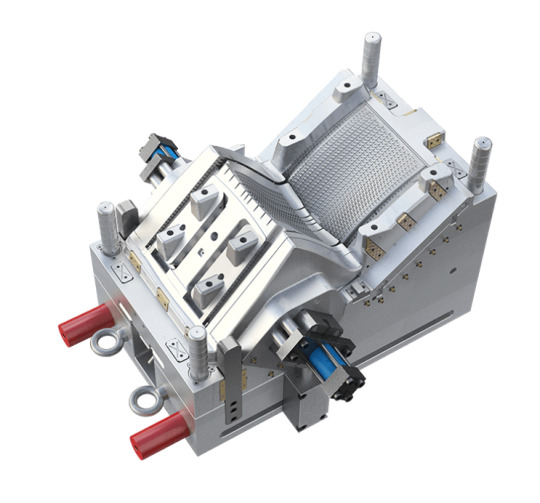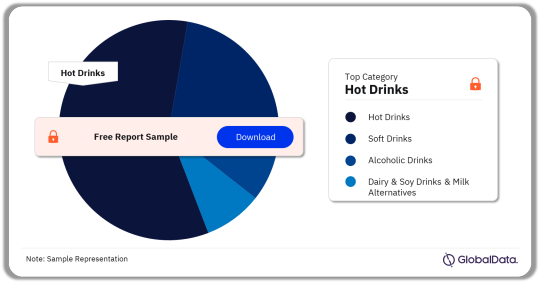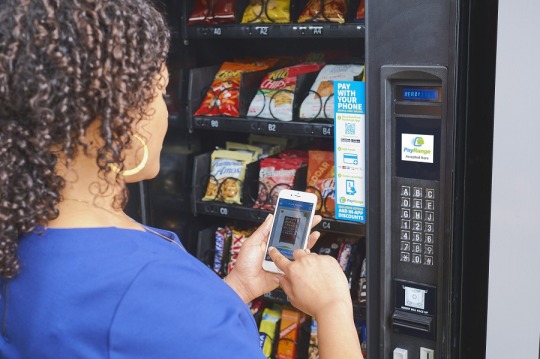#Smart Coffee Machines Market trends
Text
Smart Coffee Machines Market Growing Popularity and Emerging Trends | Morphy Richards, Rex-Royal, Gruppo Cimbali
Advance Market Analytics published a new research publication on “Global Smart Coffee Machines Market Insights, to 2027” with 232 pages and enriched with self-explained Tables and charts in presentable format. In the study, you will find new evolving Trends, Drivers, Restraints, Opportunities generated by targeting market-associated stakeholders. The growth of the Smart Coffee Machines market was mainly driven by the increasing R&D spending across the world.
Major players profiled in the study are:
Bravilor Bonamat B.V. (Netherlands), Wilbur Curtis Co. (United States), Behmor, Inc. (United States), Sunbeam Products, Inc. , Koninklijke Philips N.V. (Netherlands), N&W Global Vending S.p.A. (Italy), Franke Holding AG (Switzerland), Rex-Royal AG (Switzerland), Group SEB (France), Nestlé Nespresso (Switzerland), Gruppo Cimbali SpA (Italy), BSH Home Appliances Corporation (Germany), JURA Elektroapparate AG (Switzerland), Rancilio Group S.p.A. (Italy), De’Longhi Group (Italy), Morphy Richards (United States)
Get Exclusive PDF Sample Copy of This Research @ https://www.advancemarketanalytics.com/sample-report/22773-global-smart-coffee-machines-market-1#utm_source=DigitalJournalVinay
Scope of the Report of Smart Coffee Machines
Smart coffee machines enable to brew coffee with desired coffee strength, grind and number of cups you want. Consistent brewing and ease of use associated with smart coffee machines driving the smart coffee machines market. Some of the features of the smart coffee machine are an LCD display, wake-up mode, remote brew features, and others. These machines are integrated with Wi-Fi and Bluetooth feature hence can be operated by using smartphone applications from distant locations.
The Global Smart Coffee Machines Market segments and Market Data Break Down are illuminated below:
by Type (WiFi-enabled Coffee Machines, Bluetooth-enabled Coffee Machines), Application (Home Use, Commercial Use), Distribution Channel (Specialty retailers, Department stores, Hypermarkets and supermarkets, Online, Discount stores), Component (Pump, Boiler, Coffee Bean Grinder, Piston, Others), End Users (Fast Food Restaurants, Cafeterias, Carryout Restaurants, Fine Dining Restaurants, Casual Dining Restaurants, Hotel & Club Foodservice, Others)
Market Opportunities:
Growing Coffee Culture Leading to Rise in Demand
Rising Food and Beverage Industry in Developing Economies
Increasing Disposable Income in Emerging Countries
Market Drivers:
Increasing Demand from Coffee Shops and Restaurants
Rising Demand of Smart Coffee Machine for Office Use
Changing Lifestyle Standards Fueled By Rising Disposable Income
Market Trend:
Emphasizing On Smart Coffee Machines with Wi-Fi Connectivity
Development in Smart Connected Electronic Products
What can be explored with the Smart Coffee Machines Market Study?
Gain Market Understanding
Identify Growth Opportunities
Analyze and Measure the Global Smart Coffee Machines Market by Identifying Investment across various Industry Verticals
Understand the Trends that will drive Future Changes in Smart Coffee Machines
Understand the Competitive Scenarios
Track Right Markets
Identify the Right Verticals
Region Included are: North America, Europe, Asia Pacific, Oceania, South America, Middle East & Africa
Country Level Break-Up: United States, Canada, Mexico, Brazil, Argentina, Colombia, Chile, South Africa, Nigeria, Tunisia, Morocco, Germany, United Kingdom (UK), the Netherlands, Spain, Italy, Belgium, Austria, Turkey, Russia, France, Poland, Israel, United Arab Emirates, Qatar, Saudi Arabia, China, Japan, Taiwan, South Korea, Singapore, India, Australia and New Zealand etc.
Have Any Questions Regarding Global Smart Coffee Machines Market Report, Ask Our Experts@ https://www.advancemarketanalytics.com/enquiry-before-buy/22773-global-smart-coffee-machines-market-1#utm_source=DigitalJournalVinay
Strategic Points Covered in Table of Content of Global Smart Coffee Machines Market:
Chapter 1: Introduction, market driving force product Objective of Study and Research Scope the Smart Coffee Machines market
Chapter 2: Exclusive Summary – the basic information of the Smart Coffee Machines Market.
Chapter 3: Displaying the Market Dynamics- Drivers, Trends and Challenges & Opportunities of the Smart Coffee Machines
Chapter 4: Presenting the Smart Coffee Machines Market Factor Analysis, Porters Five Forces, Supply/Value Chain, PESTEL analysis, Market Entropy, Patent/Trademark Analysis.
Chapter 5: Displaying the by Type, End User and Region/Country 2016-2021
Chapter 6: Evaluating the leading manufacturers of the Smart Coffee Machines market which consists of its Competitive Landscape, Peer Group Analysis, BCG Matrix & Company Profile
Chapter 7: To evaluate the market by segments, by countries and by Manufacturers/Company with revenue share and sales by key countries in these various regions (2022-2027)
Chapter 8 & 9: Displaying the Appendix, Methodology and Data Source
Finally, Smart Coffee Machines Market is a valuable source of guidance for individuals and companies.
Read Detailed Index of full Research Study at @ https://www.advancemarketanalytics.com/buy-now?format=1&report=22773#utm_source=DigitalJournalVinay
Contact Us:
Craig Francis (PR & Marketing Manager)
AMA Research & Media LLP
Unit No. 429, Parsonage Road Edison, NJ
New Jersey USA – 08837
#Smart Coffee Machines market analysis#Smart Coffee Machines Market forecast#Smart Coffee Machines Market growth#Smart Coffee Machines Market Opportunity#Smart Coffee Machines Market share#Smart Coffee Machines Market trends
0 notes
Text
Single Serve Coffee Maker Market Dynamics: Global Growth and Trends (2023-2032)

The Single Serve Coffee Maker Market witnessed substantial growth, surging from USD 834.45 million in 2023 to USD 1,688 million by 2032, exhibiting a robust CAGR of 6.65%.
The single-serve coffee maker market has experienced significant growth over the past decade, driven by increasing consumer demand for convenience, personalization, and premium coffee experiences at home. This market encompasses a variety of products, including pod-based machines, capsule systems, and other single-serve brewing technologies, catering to a diverse range of tastes and preferences. One of the key factors contributing to the market's expansion is the busy lifestyle of consumers, which has heightened the appeal of quick and easy coffee preparation methods. Additionally, the proliferation of specialty coffee blends and flavors offered by single-serve coffee makers has attracted a broad consumer base, from casual coffee drinkers to connoisseurs seeking high-quality brews without the need for extensive equipment or barista skills.
Technological advancements have also played a crucial role in the market's growth, with innovations in brewing techniques, machine design, and user-friendly interfaces enhancing the overall consumer experience. The rise of eco-conscious consumers has spurred the development of more sustainable single-serve options, such as recyclable or biodegradable pods, which address environmental concerns associated with traditional single-use capsules.
The market's expansion is also supported by strategic partnerships and collaborations between coffee machine manufacturers and coffee brands, resulting in a wider range of compatible coffee products and increased brand loyalty. The growing popularity of single-serve coffee makers in both residential and commercial settings, including offices and hospitality venues, underscores their versatility and broad market appeal. As consumer preferences continue to evolve and demand for high-quality, convenient coffee solutions rises, the single-serve coffee maker market is poised for sustained growth, driven by innovation, brand differentiation, and an ever-expanding array of coffee options tailored to meet diverse consumer needs.
The single-serve coffee maker market is influenced by several trending factors that shape consumer preferences and drive market growth. These factors include:
Convenience and Speed: The primary appeal of single-serve coffee makers lies in their ability to brew a cup of coffee quickly and with minimal effort. Busy lifestyles and the desire for instant gratification have made convenience a top priority for consumers, propelling the demand for these machines.
Customization and Variety: Single-serve coffee makers offer a wide range of coffee flavors, strengths, and types, allowing consumers to customize their coffee experience. The availability of various pods and capsules, including options for specialty drinks like lattes and cappuccinos, caters to diverse tastes and preferences.
Technological Advancements: Continuous innovation in brewing technology, machine design, and smart features has enhanced the user experience. Modern single-serve coffee makers come with programmable settings, touchscreens, and connectivity options, making them more intuitive and efficient.
Sustainability Concerns: Growing environmental awareness among consumers has led to a demand for more sustainable coffee solutions. Manufacturers are responding by developing recyclable and biodegradable pods, as well as machines with eco-friendly features such as energy-saving modes.
Premium Coffee Experiences: There is an increasing trend towards premiumization in the coffee market, with consumers seeking high-quality coffee similar to what they would get in a café. Single-serve coffee makers that can replicate the café experience at home are gaining popularity.
Health and Wellness Trends: Health-conscious consumers are looking for coffee options that align with their dietary preferences, such as organic, fair-trade, and low-acid coffees. Single-serve coffee makers that offer these choices are becoming more attractive.
Brand Collaborations and Partnerships: Strategic alliances between coffee machine manufacturers and well-known coffee brands enhance product offerings and boost market presence. These collaborations often lead to the creation of exclusive coffee blends and limited-edition flavors.
Rise of Home Offices: The increase in remote work and home offices has led to higher consumption of coffee at home. Single-serve coffee makers are ideal for home office setups, providing a quick caffeine fix without the need for a full pot of coffee.
Affordability and Accessibility: While premium models are available, there are also many affordable options on the market, making single-serve coffee makers accessible to a wider range of consumers. Retail promotions and discounts further drive adoption.
Cultural Shifts: Changing cultural attitudes towards coffee consumption, with coffee increasingly seen as an integral part of daily life and social interactions, support the growth of the single-serve coffee maker market. This trend is particularly strong among younger consumers who value convenience and quality.
Key Players:
Hamilton Beach Brands
LUIGI LAVAZZA SPA.
Cuisinart
The Black & Decker Corporation
JURA Elektroapparate AG
Nestlé Nespresso S.A.
Keurig Dr Pepper Inc
Sunbeam Products
De’Longhi Appliances S.r.l.
BUNN
More About Report- https://www.credenceresearch.com/report/single-serve-coffee-maker-market
The single-serve coffee maker market is highly competitive, characterized by the presence of several key players, each striving to differentiate their offerings through innovation, branding, and strategic partnerships. Here is a detailed competitive analysis of the market:
Market Position: A significant competitor with a focus on convenience and variety.
Strengths: Broad selection of beverages beyond coffee, including tea and hot chocolate, compatibility with a variety of brands.
Innovations: Tassimo's Intellibrew technology, which reads barcodes on T-Discs to automatically adjust brewing parameters for optimal results.
Market Trends and Strategies:
Product Differentiation: Companies are focusing on unique features such as programmable settings, connectivity (Wi-Fi and Bluetooth), and personalized brewing options to attract consumers.
Sustainability Initiatives: With increasing environmental concerns, many brands are developing eco-friendly products. This includes recyclable and biodegradable pods, energy-efficient machines, and commitments to reduce carbon footprints.
Expansion of Product Lines: Key players are broadening their product lines to include machines that cater to different preferences and price points, from basic models to high-end machines with advanced features.
Brand Collaborations and Licensing: Partnerships between coffee machine manufacturers and well-known coffee brands (e.g., Starbucks, Dunkin' Donuts) help expand product offerings and enhance brand loyalty.
Direct-to-Consumer Sales: Many brands are enhancing their online presence and direct-to-consumer sales channels to provide a more personalized shopping experience and better control over branding and pricing.
Market Penetration in Emerging Economies: Companies are increasingly targeting emerging markets where coffee consumption is on the rise, offering affordable models to capture new consumer segments.
Competitive Challenges:
Price Sensitivity: With a wide range of products available, price remains a significant factor influencing consumer decisions. Brands must balance between offering advanced features and maintaining affordability.
Technological Advancements: Rapid technological changes require continuous investment in R&D to stay ahead of competitors and meet evolving consumer expectations.
Sustainability Pressure: Growing demand for sustainable products puts pressure on companies to innovate in packaging and manufacturing processes while maintaining profitability.
Segments:
By Type:
8 Oz
10 Oz
12 Oz
More than 12 Oz
By Application
E-Commerce
Boutiques
By Industry Vertical
Consumer Goods
Food & Beverage
Restaurants & Cafeterias
Browse the full report – https://www.credenceresearch.com/report/single-serve-coffee-maker-market
Browse Our Blog: https://www.linkedin.com/pulse/single-serve-coffee-maker-market-projections-global-industry-v2hnc
Contact Us:
Phone: +91 6232 49 3207
Email: [email protected]
Website: https://www.credenceresearch.com
0 notes
Text
Craft Coffee Trends: Innovations Shaping the Future of Artisanal Coffee

The craft coffee scene is ever-evolving, driven by innovation and a relentless pursuit of quality. Today's coffee enthusiasts are not just satisfied with the traditional cup; they are on the lookout for new experiences and flavors that push the boundaries of what coffee can be. From the introduction of nitro-infused beverages to the merging of coffee with unexpected partners like beer, and the advent of high-tech coffee gadgets, the artisanal coffee landscape is buzzing with exciting developments. Here, we delve into some of the most compelling trends that are shaping the future of craft coffee.
Nitro Coffee: Smooth, Creamy, and Revolutionary
One of the most noticeable trends in the craft coffee world is the rise of nitro coffee. This unique beverage involves infusing cold brew coffee with nitrogen gas, creating a silky, smooth texture that enhances the coffee's natural flavors. The result is a creamy, frothy coffee that pours much like a stout beer, complete with a rich head. The introduction of nitrogen not only changes the mouthfeel and visual appeal but also reduces the acidity, making it a gentler option on the stomach.
Nitro coffee first gained popularity in specialty coffee shops and has now found its way into mainstream cafes and even retail stores. For those interested in the science and process behind nitro coffee, Cafe Degen provides a deep dive into how nitrogen transformation elevates the humble cup of coffee to something extraordinary.
Coffee Beer: Where Brew Meets Brew
The fusion of coffee and beer is not entirely new, but craft brewers and coffee roasters are taking this combination to new heights. Coffee beer typically involves brewing beer with coffee beans, imbuing the beer with rich coffee flavors that complement the malty sweetness of the beer. This trend is particularly popular among craft breweries that are experimenting with different bean varieties and brewing techniques to create complex flavor profiles.
For enthusiasts eager to explore the intricacies of coffee beers and their brewing methods, informative resources like Brewing Coffee Manually offer detailed insights and reviews on the latest coffee-infused beers in the market.
Coffee Tech Gadgets: Brewing at the Cutting Edge
Technology has not left the coffee industry behind. Today, a myriad of gadgets promise to enhance the brewing process, improve precision, and ensure consistency. From smart coffee makers that can be controlled via smartphone apps to advanced espresso machines that fine-tune temperature and pressure, the options are vast. One notable innovation is the use of scales integrated with timers and apps, which guide users through the brewing process to achieve the perfect extraction.
For those who love combining technology with traditional coffee brewing, Coffee Geek offers comprehensive reviews and tutorials on the latest gadgets that every home barista should consider.
Sustainability and Transparency: More Than Just Buzzwords
As the craft coffee industry grows, so does the focus on sustainability and transparency. Consumers are increasingly interested in where their coffee comes from, how it is produced, and its impact on the environment. Craft roasters and cafes are responding by sourcing beans ethically, adopting more sustainable practices, and providing consumers with detailed information about the origin and journey of their coffee.
Websites like Perfect Daily Grind provide a wealth of information on sustainable practices within the coffee industry, helping consumers and businesses alike make more informed choices.
Looking Forward: The Future of Craft Coffee
As we look to the future, the craft coffee industry is set to continue its trajectory of innovation and excellence. With new brewing techniques, unexpected flavor pairings, and an increasing emphasis on sustainability, the world of artisanal coffee is more exciting than ever. Whether you're a seasoned coffee aficionado or a curious newcomer, these trends offer fresh ways to enjoy and appreciate the complexities of coffee.
In embracing these innovations, coffee lovers not only enhance their own experience but also support a vibrant community of roasters, brewers, and innovators who are passionate about bringing the best out of every bean. So, the next time you sip your morning brew, remember that it's not just a cup of coffee—it's a part of a larger, ever-evolving craft.
#Craft Coffee Innovations#Nitro Coffee Trends#Coffee Technology Gadgets#Sustainable Coffee Practices#Coffee and Beer Fusion
0 notes
Text
Revolutionizing Retail: The Power of A and M Vending Machines
In today's fast-paced world, convenience is key. A and M vending machines have emerged as a solution to meet the evolving needs of consumers and businesses alike. These automated marvels offer quick access to snacks, beverages, and other products, revolutionizing the retail experience. Let's delve into the world of A and M vending and uncover its significance in modern society.
History of Vending
Vending machines trace their origins back to ancient Greece, where holy water was dispensed for a coin. Over the centuries, these machines evolved, with the first modern vending machine dispensing postcards in the early 1880s. Today, vending technology has undergone remarkable advancements, catering to a wide range of products and industries. The proliferation of vending machines has significantly influenced consumer behavior, providing convenient access to goods on-the-go.
Types of Vending Machines
Snack Vending Machines: These machines offer a wide array of snacks, ranging from chips and candies to healthy options like granola bars and fruit cups.
Beverage Vending Machines: Quench your thirst with a variety of beverages, including sodas, juices, water, and even specialty drinks like iced coffee and energy drinks.
Specialized Vending Machines: From fresh food vending machines at airports to prescription medication dispensers in pharmacies, specialized vending machines cater to diverse consumer needs.
Benefits of A and M Vending
The allure of A and M vending lies in its myriad benefits. For consumers, these machines provide unmatched convenience, allowing for quick and easy access to desired products. For businesses, vending machines represent a lucrative revenue stream with minimal overhead costs. Additionally, the scalability of vending operations makes them an attractive investment opportunity for entrepreneurs.
Challenges and Solutions
Despite their many advantages, vending machines are not without challenges. Maintenance and servicing can be cumbersome, requiring timely repairs to ensure uninterrupted operation. Security concerns, such as vandalism and theft, necessitate robust security measures and surveillance systems. However, advancements in technology have led to innovative solutions, including remote monitoring and predictive maintenance, to address these challenges effectively.
Technology in Vending
A and M vending machines have embraced cutting-edge technology to enhance the user experience. Cashless payment systems, such as mobile wallets and contactless cards, have streamlined transactions, eliminating the need for cash. Furthermore, IoT integration has enabled smart vending solutions, allowing operators to monitor inventory levels in real-time and optimize machine performance. Data analytics play a crucial role in predicting consumer preferences and optimizing product offerings.
Future Trends
The future of A and M vending is brimming with possibilities. Personalization will take center stage, with vending machines offering tailored recommendations based on individual preferences and purchasing history. Integration with artificial intelligence will enable predictive inventory management, ensuring optimal stock levels and minimizing waste. Moreover, vending machines will expand into new markets and industries, catering to a diverse range of consumer needs.
Regulations and Compliance
As with any industry, A and M vending is subject to regulations and compliance standards. Food safety regulations govern the handling and storage of perishable goods, ensuring consumer safety. ADA compliance ensures accessibility for individuals with disabilities, with requirements for machine placement and operation. Licensing and permits are also required for vending machine businesses, varying depending on location and jurisdiction.
Impact on Retail Industry
The rise of A and M vending has implications for the retail industry as a whole. Traditional retail stores face increased competition from vending machines, which offer convenience and accessibility to consumers. However, there are opportunities for collaboration between vending machine operators and retailers, leveraging each other's strengths to enhance the overall shopping experience. Furthermore, vending machines are disrupting traditional supply chain models, offering a direct-to-consumer distribution channel for manufacturers.
Case Studies
Examining successful implementations of A and M vending provides valuable insights into best practices and lessons learned. From innovative design concepts to strategic placement strategies, case studies highlight the versatility and effectiveness of vending machine solutions. By studying both successes and failures, businesses can glean valuable lessons to inform their own vending strategies.
A and M Vending in Pandemic
The COVID-19 pandemic brought unprecedented challenges to the retail industry, including A and M vending. However, vending machines quickly adapted to the new normal, offering contactless transactions and adhering to social distancing measures. As the world emerges from the pandemic, A and M vending will continue to play a vital role in providing safe and convenient access to essential goods.
Conclusion
In conclusion, A and M vending machines are revolutionizing the retail landscape, offering unparalleled convenience, flexibility, and innovation. From snacks and beverages to everyday essentials, these automated wonders are reshaping the way consumers shop. As technology continues to evolve and consumer preferences shift, the future of A and M vending holds limitless possibilities.
FAQs
Are A and M vending machines environmentally friendly?
Yes, many A and M vending machines are equipped with energy-efficient features and use recyclable materials to minimize their environmental impact.
How do vending machines detect counterfeit currency?
Vending machines employ a variety of security features, including optical scanners and magnetic sensors, to detect counterfeit currency.
Can A and M vending machines be customized to specific product requirements?
Yes, A and M vending machines can be tailored to accommodate a wide range of products, from snacks and beverages to electronics and personal care items.
What measures are in place to ensure food safety in vending machines?
Vending machine operators adhere to strict food safety regulations, including regular cleaning and maintenance procedures, to ensure the integrity of perishable goods.
Are there any age restrictions for purchasing items from vending machines?
Age restrictions may apply to certain products, such as alcoholic beverages or tobacco products, depending on local laws and regulations.
How do vending machine operators address inventory management challenges?
Vending machine operators utilize data analytics and predictive algorithms to optimize inventory levels and minimize stockouts, ensuring a seamless shopping experience for consumers.
0 notes
Text
Comprehensive Market Research Analysis on “Global Smart Farming Industry” | BIS Research

The Global Smart Farming Industry is undergoing a profound transformation, marked by technological innovations and a paradigm shift in traditional agricultural practices.
In this market research analysis by BIS Research, let’s delve into the intricate landscape of smart farming, exploring key trends, challenges, and the promising future that lies ahead.
The Global Smart Farming Market was valued at $15.06 billion in 2022 and is expected to reach $33.0 billion in 2027, following a CAGR of 16.99% during 2022-2027.
The Landscape of Smart Farming Revolution
Smart farming, powered by cutting-edge technologies, is reshaping the agricultural landscape. BIS Research's detailed market analysis illuminates the factors propelling this revolution, offering insights into the dynamic interplay between technology and agriculture.
Key Findings and Trends
IoT Integration and Connectivity: The integration of Internet of Things (IoT) devices is a driving force behind the smart farming revolution. BIS Research's analysis highlights the surge in connected devices, sensors, and real-time data transmission, enabling farmers to make informed decisions for optimal crop management.
Precision Agriculture Technologies: Precision agriculture takes center stage in the smart farming industry. BIS Research's findings underscore the adoption of precision technologies, including GPS-guided machinery, drones, and advanced sensors. These technologies enhance efficiency, reduce resource wastage, and optimize overall farm performance.
Data-Driven Decision-Making: The era of data-driven agriculture is here. BIS Research's market research analysis reveals the pivotal role of data in smart farming. Farmers leverage analytics and machine learning to derive actionable insights, facilitating informed decisions on crop health, resource allocation, and risk management.
Get Free Detailed Insights on Global Smart Farming Market Report by BIS Research.
Challenges and its Solutions
Initial Investment Costs: BIS Research's analysis acknowledges the challenge of initial investment costs for farmers transitioning to smart farming practices. However, the report also delves into the long-term benefits, emphasizing the return on investment through increased productivity and sustainable practices.
Data Security and Privacy Concerns: As smart farming relies heavily on data, BIS Research addresses the concerns surrounding data security and privacy. The report outlines measures and best practices to ensure the secure handling of sensitive agricultural data.
Key Companies Based on Precision Farming & Farm Management
Climate LLC
AGCO Corporation
Hexagon Agriculture
CNH Industrial N.V.
Trimble Inc.
Ag Leader Technology
CropX inc.
Deere & Company
BASF SE
Kubota Corporation
Regional Insights
BIS Research's market analysis extends beyond global trends to provide region-specific insights. From North America's early adoption to Asia-Pacific's emerging market dynamics, the report offers a nuanced understanding of how smart farming is evolving across different geographical landscapes in the agriculture industry.
Recent Developments in the Industry
January 2022: Hexagon Agriculture's HxGN AgrOn Planting Assistant:
Hexagon Agriculture introduced HxGN AgrOn planting assistant technology.
Aims to enhance accuracy in shovel planting.
Applicable to various crops, including palm oil, coffee, banana, and citrus.
October 2022: Trimble Inc.'s Precision Agriculture Displays:
Trimble Inc. launched new agriculture displays, Trimble GFX-1060 and GFX-1260.
Designed for precision agriculture applications.
Offers next-generation performance and enhanced connectivity for in-field operations.
June 2022: BASF's Acquisition of Horta S.r.l.:
BASF acquired Horta S.r.l., an Italian digital farming solutions company.
Horta specializes in agronomic Decision Support Systems (DSS).
Expertise in innovative solutions for crops like grapes, tomatoes, cereals, and olives.
Future Outlook and Innovations
The BIS Research analysis peers into the crystal ball of the smart farming industry, anticipating future trends and innovations. From advancements in artificial intelligence to the role of 5G connectivity, the report outlines the technological trajectory that will shape the future of agriculture.
Conclusion
In conclusion, BIS Research's detailed market research analysis on the Global Smart Farming Industry paints a comprehensive picture of an industry in the midst of a technological revolution. As smart farming continues to evolve, driven by innovation and sustainability, the report serves as a guiding beacon for stakeholders navigating the dynamic landscape of modern agriculture.
#Global Smart Farming Market#Global Smart Farming Report#Global Smart Farming Industry#Global Smart Farming Market Research#Global Smart Farming Market Trend#Global Smart Farming Market Forecast#Global Smart Farming Market CAGR#Global Smart Farming Industry Analysis#Global Smart Farming Market Growth#Global Smart Farming Market Report#BIS Research
0 notes
Text
Datafication: How Smart Business Optimize Data for Success
Digitalization and advancement in technology have made all the processes in business and daily activities easier. The key component of digitalization and automation technology is data. Datafication can be the single solution for all the processes related to data from data gathering to data analysis. In today’s world datafication has become an inevitable process in the organization as it can be used in multiple areas and sectors of management. This article let us learn more about datafication and its essence in the business analysis and growth of the organization.

Before knowing the data strategy and its implementation methods we will first understand What is Datafication?
To simply define the meaning of datafication, it is transforming or converting multiple aspects of business, society, and daily life into data. From buying a coffee to searching for something on Google anything we do daily will generate data. The process involves various stages like capturing, digitizing, and utilizing information for decision-making, improving efficiency, and discovering valuable insights.
In the business, sectors can gain the ultimate use of datafication as it can provide you insights about business patterns and customer satisfaction. It also helps to keep track of digital services. All these insights when analyzed clearly can give you new patterns and strategies for excelling your business in the market.
Visit Apac Business Times for more Business Trends
Methods involved in Datafication
In the process of datafication initial step is data collection. Here relevant data is collected or gathered from sources. There are multiple sources like online behavior, social media, purchase history, customer interaction, operational process, market trends, etc. The next is the activity of converting the collected information from analog form to digital format, which makes it easier to store, manipulate, and extract hidden patterns. This process is called digitization.
As a huge amount of data is been collected from sources it needs robust storage and management systems. In this phase cloud storage, data warehouse, big data, and other storage techniques are utilized in organizing and maintaining data of large volumes. Next comes the important and core part of datafication called data analysis. With the use of machine learning, data visualization, statistical analysis, and other techniques organizations can formulate meaningful patterns and hidden information for business strategies.
Datafication is a never-ending process as every day the data will not be the same. People’s interests change and market trends as well, hence organizations should monitor and distill the data strategies. This continuous analysis will enhance business growth and find new strategies for success.
Benefits of Datafication in Business
Datafication is beneficial in many ways from the organizational perspective some of which are mentioned here. It helps with decision-making, businesses utilize the technological tools to make informed decisions. With the analysis of vast datasets, organizations can take directions that are fact-driven rather than intuition. Operational efficiency is achieved through datafication as it automates tasks, optimizes workflows, etc which will increase productivity and make it cost-effective.
Datafication provides a way to understand customer behaviour and areas of interest about each individual. This insight will help businesses create personalized experiences, tailoring products, services, and marketing that attract all customers. In the predictive analysis approach, businesses can foresee future trends and predict challenges that they might face. The well-informed challenges can be tackled and handled with new strategies and can cope with the arriving market trends.
It also acts as a catalyst for innovation as you can identify future opportunities and create solutions which in turn make you stand ahead in the race. Along with the benefits, there are also certain challenges in datafication. Privacy and security of data are the major concerns and factors that every organization must prioritize as data collected will have details information about the customer.
Conclusion
In short, datafication is one of the emerging technological trends in the business sector. It is also a transformative force in analyzing and predicting future market trends that can be inculcated by businesses in meeting customer expectations and attaining customer satisfaction. With the proper and effective use of datafication, an organization can make productive strategies to empower business growth and success.
Visit More : https://apacbusinesstimes.com/datafication-how-smart-business-optimize-data-for-success/
0 notes
Text
Vending Machine Industry: Convenience Takes Center Stage (2024)
Market Overview
The global vending machine industry, valued at USD 18.3 billion in 2022, is experiencing steady growth, projected to reach USD 37.2 billion by 2032 (CAGR of 7.5%). This expansion is fueled by a confluence of factors, including urbanization, changing lifestyles, disposable income growth, and relentless technological innovation.
Key Market Dynamics
Urbanization & On-the-Go Lifestyles: Rapid urbanization worldwide increases the demand for accessible 24/7 food and beverage options. Busy schedules drive consumers towards vending machines for quick, convenient solutions.
Disposable Income Growth: Rising disposable income, particularly in developing economies, opens opportunities for purchasing goods and services from vending machines.
Shifting Consumer Preferences: Health consciousness promotes demand for healthier snacking choices and organic beverages. Product innovation within vending machines allows for catering to diverse preferences.
Technological Reinvention: Advanced features like cashless payments, touchless interfaces, remote monitoring, and AI-powered inventory management enhance the vending experience and optimize operations.
Diversification Beyond Snacks: Vending machine offerings expand to include fresh food, hot meals, personal care items, and even electronics accessories, transforming them into micro convenience stores.

Segment Performance
Beverages: Maintain the highest market share due to the constant demand for hot and cold beverages such as coffee, tea, soft drinks, and functional drinks.
Food: Experience the highest CAGR, driven by the proliferation of food vending machines offering snacks, confectionery, pre-packaged fresh meals, and even hot meal options.
Non-Food: This rapidly emerging segment is diversifying vending machine offerings with personal care items, electronics, over-the-counter medications, and more.
Regional Dynamics:
North America: Holds the largest market share due to established vending infrastructure and widespread adoption.
Asia Pacific: Expected to witness the fastest growth due to massive urbanization, rising income levels, and an openness to technological advancements.
Europe: Maintains a robust presence, focusing on regional preferences, healthy options, and innovation.
Rest of the World: Presents increasing potential with developing economies, particularly in Latin America and Africa.
Strategic Imperatives for Success
Innovation as the Core: Investment in smart technologies, such as AI-powered recommendations, predictive analytics, and seamless payment solutions, enhance user experience and operational efficiency.
Consumer-Centric Approach: Cater to health trends, dietary restrictions, and emerging preferences with diverse product offerings.
Strategic Expansion: Target high-traffic areas like workplaces, airports, transportation hubs, educational institutions, and healthcare facilities.
Data Analytics: Leverage data from connected vending machines to gain real-time insights for inventory optimization, marketing, and pricing.
Sustainability as a Differentiator: Implement eco-friendly practices, utilizing energy-efficient machines, recyclable packaging, and responsible waste management.
The Future of Vending
The vending machine industry is transforming into a hub for convenience and accessibility. From personalized experiences to sustainable solutions, companies that prioritize innovation and consumer demands will reap the rewards in this exciting and dynamic market landscape.
Additional Considerations
Government Regulations: Understanding regional restrictions on placement or certain types of products offered through vending machines is crucial.
Supply Chain Collaboration Partnering with suppliers and manufacturers for product innovation and inventory management is key.
0 notes
Text
Exploring The World Of Plastic Home Appliance Mould
In the bustling realm of home appliance manufacturing, a crucial yet often overlooked element lies at the heart of every product's creation: the Plastic Home Appliance Mould. These moulds are the unsung heroes of the industry, responsible for shaping the plastic components that bring functionality and style to our everyday lives. From the coffee machine that kickstarts our mornings to the blender that whips up our evening cocktails, each appliance owes its form to the precision engineering of these versatile moulds.

The process of designing and crafting Plastic Home Appliance Moulds is a meticulous art that demands skill, expertise, and a keen eye for detail. Each mould must be tailored to the specific requirements of the appliance, taking into account factors such as material properties, dimensions, tolerances, and aesthetics. Engineers and designers collaborate to create moulds that not only ensure the structural integrity of the appliance but also its user-friendliness and visual appeal.
Plastic Home Appliance Moulds are typically made from high-quality steel or aluminum, providing the necessary durability for mass production. These materials allow for the intricate details of the design to be faithfully reproduced in every plastic part, ensuring consistency and quality across thousands of units. The moulds themselves are created using advanced technologies such as computer-aided design (CAD) and computer-aided manufacturing (CAM), which enable the high levels of precision and efficiency.
One of the key advantages of Plastic Home Appliance Moulds is their versatility. They can be used to produce a wide range of appliances, from small kitchen tools to large household items. This adaptability makes them an important asset in the manufacturing industry, allowing for rapid prototyping and quick adaptation to market trends and consumer demands.
Another benefit of using Plastic Home Appliance Moulds is their cost-effectiveness. Once the initial investment in the mould is made, the per-unit cost of production decreases significantly due to the economies of scale. This efficiency makes it possible for manufacturers to offer affordable products without sacrificing quality or performance.
Plastic Home Appliance Moulds also play a critical role in sustainable manufacturing. By using recyclable materials and improving the production process, manufacturers can reduce waste and reduce their environmental impact. Additionally, plastic appliances tend to be lighter than their metal counterparts, reducing shipping costs and energy consumption during use.
As technology continues to advance, Plastic Home Appliance Moulds are becoming even more sophisticated. Features such as micro-texturing, undercuts, and multi-cavity designs are being incorporated to enhance functionality and appearance. Smart sensors and integrated circuitry are also being added to appliances, further increasing the complexity of the moulds required to produce them.
Despite the many challenges involved in creating Plastic Home Appliance Moulds, the end result is always rewarding. When a consumer brings home a new appliance, they expect it to be reliable, efficient, and aesthetically pleasing. It is the mould that makes this possible, silently contributing to the success of the product and the satisfaction of the end user.
0 notes
Text
Decoding the Portable Ultrasound Devices Market: Tech Marvels and Healthcare Heroes
Greetings, curious minds! Today, let’s take a stroll through the dynamic world of portable ultrasound devices, where state-of-the-art technology meets medical marvels. No lab coats or complex lingo needed — we’re keeping it casual and breaking down the buzz without the fluff.

The Portable Ultrasound Devices Market Snapshot
Imagine this: the global portable ultrasound devices market, hitting a cool USD 1.70 billion in 2021, is gearing up to become the rockstar of the medical tech scene, projecting a climb to USD 2.78 billion by 2030. That’s a steady 5.6% CAGR — no flashy fireworks, just a steady ascent.
Why the Buzz?
The medical tech scene is buzzing with advancements, and patients today lean towards treatments that don’t feel like a sci-fi experiment. Enter portable ultrasound devices — the unsung heroes of emergency care, making doctors feel like real-life superheroes with their compact imaging systems.
Market Insights — (2023–2030)
Global Market Size: USD 1.70 billion (Yes, with a ‘B’)
Leading Segment: Laptop-based ultrasound devices (because laptops are the reliable workhorses)
Growth Rate: 5.6% CAGR (Steady as she goes)
The Regional Landscape
North America is flexing its medical muscle, claiming over 40% of the portable ultrasound devices market. Meanwhile, Asia Pacific is gearing up for a growth spurt with a promising 6.7% CAGR — the speedster of the market in 2022. Go, Asia Pacific!
Types in the Limelight
Now, let’s chat about types — laptop-based versus handheld ultrasound devices. The handheld crew is stealing the spotlight, commanding over 55% of the market share. Why? Because technology evolves, and handheld devices offer crisp images.
Laptop-based ultrasound devices, on the other hand, are the Swiss Army knives of medical settings — compact, versatile, and with a battery life that rivals your latest Netflix binge.
Applications in the Spotlight
Obstetrics/Gynecology takes center stage, reigning with over 45% of the market share. Hand-held and laptop-based devices steal the show with high-end imaging techniques. Cardiovascular applications are expected to be the heartthrob of the market, with a sizzling 7.1% CAGR. Talk about heart-racing growth!
Market Dynamics Drama
Now, let’s discuss what makes these ultrasound devices tick — the drivers and restraints.
Drivers: Growing patient population with lung diseases and lifestyle-based disorders. Apparently, our lungs are the cool kids at this medical party.
Restraints: Strict government regulations and a shortage of skilled personnel. Because, you know, too many rules and not enough smart folks.
For More Information: https://www.skyquestt.com/report/portable-ultrasound-devices-market
Competition in the Ultrasound Arena
The market is a dynamic battlefield with big players like General Electric, Siemens, and Philips flaunting their tech muscles. Innovation is the name of the game. Smaller players are also making waves, focusing on niche solutions like your favorite artisanal coffee shop, but for ultrasound devices.
Recent Developments:
FUJIFILM introduced the Sonosite LX, a noteworthy addition to the point-of-care ultrasound systems.
Philips launched Lumify, a handheld device with more measuring functionalities than your fitness tracker.
Key Market Trends — Because Trends Make Everything Cooler
Technological Convergence with Other Devices: Ultrasound devices are teaming up with smartphones and tablets — because why not? It’s like the Avengers assembling for a medical mission.
Final Thoughts
In a nutshell, the global portable ultrasound devices market is a dynamic mix of technology, innovation, and medical wonders. As patients embrace non-invasive treatments, these handheld and laptop-based devices are becoming the unsung heroes of the medical tech realm.
And there you have it — a peek into the future where ultrasound devices aren’t just machines; they’re the cool cats of the medical tech world. Stay tuned for more updates from the intersection of science and swagger!
About Us-
SkyQuest Technology Group is a Global Market Intelligence, Innovation Management & Commercialization organization that connects innovation to new markets, networks & collaborators for achieving Sustainable Development Goals.
Contact Us-
SkyQuest Technology Consulting Pvt. Ltd.
1 Apache Way,
Westford,
Massachusetts 01886
USA (+1) 617–230–0741
Email- [email protected]
Website: https://www.skyquestt.com
0 notes
Text
Smart Farming Market Size, Volume, Demand, Outlook and Forecast

The global smart farming market was valued at $15.06 billion in 2022 and is expected to reach $33.0 billion in 2027, following a CAGR of 16.99% during 2022-2027. The growth in the global smart farming market is expected to be driven by increase in adoption of IoT and artificial intelligence, digitalization of agriculture operations, rise in dependence on advanced technologies to enhance production across the globe.
The agricultural landscape is undergoing a digital revolution, and at the forefront of this transformation is the global smart farming market.
Market Drivers:
Population Growth and Food Security:
With the global population projected to exceed 9 billion by 2050, the demand for food is escalating. Smart farming technologies enable farmers to increase productivity and optimize resource utilization, contributing to global food security.
Environmental Sustainability:
Sustainable agriculture is a priority, given the environmental challenges associated with traditional farming practices. Smart farming integrates technologies like precision irrigation, drones, and sensor networks to minimize environmental impact by reducing water usage, chemical inputs, and soil erosion.
Labor Efficiency and Cost Savings:
Automation and data-driven decision-making enable farmers to streamline operations, reduce manual labor, and cut costs. This increased efficiency is particularly crucial as labor shortages become a prevalent issue in the agriculture sector.
Technological Advancements:
The rapid development of technologies such as the Internet of Things (IoT), artificial intelligence (AI), and machine learning is driving the smart farming market. These technologies enable real-time monitoring, data analytics, and predictive modeling for more informed and efficient farming practices.
Recent Developments in Global Smart Farming Market
• In January 2022, Hexagon Agriculture launched a new technology named HxGN AgrOn planting assistant. This new technology is aimed at improving accuracy in shovel planting. This item can also be adopted by other types of crops, such as palm oil, coffee, banana, and citrus.
• In October 2022, Trimble Inc. launched new agriculture displays, such as Trimble GTX-1060 and GTX-1260, for precision agriculture applications. These displays provide next-generation performance and connectivity for in-field operations.
• In June 2022, BASF acquired Horta S.r.l., an Italian company specialized in digital farming solutions. Horta is an established player for the development of highly innovative agronomic Decision Support Systems (DSS) for crops such as grapes, tomatoes, cereals and olives.
• In August 2022, CropX inc. launched a continuous nitrogen leaching monitoring capability for its farm management system. This new development would track the nitrogen movement and salts in the soil.
Download Sample Report to learn about recent trends in the Smart Pharming Market observed by BIS Research.
Market Segmentation:
By Application
By Product Type
By Region
Precision Agriculture:
Precision agriculture involves the use of GPS-guided tractors and equipment, satellite imagery, and sensor technology to optimize field-level management with regard to crop farming.
IoT and Sensor Networks:
The Internet of Things connects devices and sensors across the farm, providing real-time data on soil conditions, crop health, and weather patterns. This data is crucial for making informed decisions and optimizing resource use.
Drones and Unmanned Aerial Vehicles (UAVs):
Drones equipped with cameras and sensors offer a bird's-eye view of the fields, allowing farmers to monitor crop health, assess field conditions, and identify potential issues such as pest infestations or nutrient deficiencies.
Machine Learning and AI:
Machine learning algorithms analyze vast amounts of data to provide insights into crop management, pest control, and irrigation scheduling. AI-powered tools help farmers make data-driven decisions for improved yield and resource efficiency.
Market Trends:
Farm Management Software:
The adoption of farm management software is on the rise, providing farmers with comprehensive tools for planning, monitoring, and analyzing various aspects of their operations.
Blockchain in Agriculture:
Blockchain technology is being explored to enhance transparency and traceability in the agricultural supply chain, ensuring the authenticity and quality of agricultural products.
Robotics in Agriculture:
The use of robotics in agriculture is increasing, with automated machines capable of tasks such as planting, harvesting, and weeding, contributing to increased efficiency and reduced labor requirements.
Market Outlook:
The global smart farming market is poised for substantial growth as agriculture continues to embrace digital technologies. As farmers worldwide recognize the benefits of precision agriculture in terms of increased productivity, sustainability, and cost savings, the market is expected to expand across regions and crops. With ongoing technological advancements, the smart farming revolution is set to play a pivotal role in shaping the future of agriculture, ensuring a more sustainable and resilient food supply chain.
Conclusion:
Smart farming represents a paradigm shift in agriculture, aligning traditional practices with advanced technologies to meet the challenges of a growing population, environmental sustainability, and resource constraints. As the global smart farming market continues to evolve, the integration of innovative technologies is set to empower farmers, optimize production, and contribute to a more sustainable and resilient agricultural ecosystem. The journey towards a smarter, more connected, and sustainable future for farming is well underway.
#Smart Pharming Market#Smart Pharming Market Report#Smart Pharming Market Size#Smart Pharming Market Trends
0 notes
Text
Household Appliances Market Overview: Growth Factors and Future Trends (2023-2032)

The global demand for Household Appliances was valued at USD 602514.2 million in 2023 and is expected to reach USD 1035351.78 million in 2032, growing at a CAGR of 6.20% between 2024 and 2032.
The household appliances market encompasses a wide range of devices and equipment used for everyday domestic tasks such as cooking, cleaning, and food preservation. This market includes major appliances like refrigerators, washing machines, dishwashers, ovens, and air conditioners, as well as small appliances such as microwaves, vacuum cleaners, coffee makers, and blenders. The growth of this market is driven by factors such as increasing urbanization, rising disposable incomes, and technological advancements that enhance convenience and efficiency.
Consumers are increasingly seeking smart appliances with features like energy efficiency, connectivity, and automation, which allow for better control and monitoring of household tasks. Additionally, the trend towards sustainable living is leading to a higher demand for eco-friendly and energy-efficient appliances. Key players in the market, such as Whirlpool, Samsung, LG, and Electrolux, continually innovate to meet evolving consumer preferences and regulatory standards. The household appliances market is highly competitive and global, with significant growth potential in emerging economies where rising living standards and expanding middle classes are driving demand for modern home conveniences.
Major Household Appliances-
Refrigerators: Used for preserving food by keeping it cold.
Washing Machines: Used for cleaning clothes automatically.
Dishwashers: Used for cleaning dishes and utensils.
Ovens: Used for baking, roasting, and cooking food.
Air Conditioners: Used for cooling and sometimes heating indoor air.
Microwaves: Used for quick cooking, heating, and defrosting food.
Dryers: Used for drying clothes after washing.
Small Appliances-
Vacuum Cleaners: Used for cleaning floors, carpets, and upholstery.
Coffee Makers: Used for brewing coffee.
Blenders: Used for blending, mixing, and pureeing food and drinks.
Toasters and Toaster Ovens: Used for toasting bread and baking small items.
Electric Kettles: Used for boiling water quickly.
Irons: Used for removing wrinkles from clothes.
Food Processors: Used for chopping, slicing, and dicing food.
Kitchen Appliances-
Stoves and Cooktops: Used for cooking food using gas or electricity.
Slow Cookers: Used for cooking food at low temperatures over a long period.
Pressure Cookers: Used for cooking food quickly under high pressure.
Rice Cookers: Used for cooking rice perfectly and sometimes other grains.
Juicers: Used for extracting juice from fruits and vegetables.
Cleaning Appliances-
Steam Mops: Used for deep cleaning floors with steam.
Robotic Vacuum Cleaners: Automated devices used for cleaning floors without manual intervention.
Carpet Cleaners: Used for deep cleaning carpets.
Personal Care Appliances-
Hair Dryers: Used for drying hair quickly.
Electric Shavers: Used for shaving facial or body hair.
Hair Straighteners: Used for straightening hair.
Home Comfort Appliances-
Humidifiers: Used for adding moisture to the air.
Dehumidifiers: Used for removing moisture from the air.
Heaters: Used for providing warmth during cold weather.
Fans: Used for circulating air and providing cooling.
Health and Wellness Appliances-
Air Purifiers: Used for cleaning the air of pollutants and allergens.
Water Purifiers: Used for making drinking water safe and clean.
Electric Massagers: Used for relieving muscle tension and pain.
Household Appliances Market Challenges:
Intense Competition-
Market Saturation: The household appliances market is highly competitive, with numerous established brands and new entrants constantly vying for market share.
Price Wars: Intense competition often leads to price wars, which can erode profit margins for manufacturers and retailers.
Technological Advancements-
Rapid Innovation: The fast pace of technological advancements requires companies to continually invest in research and development to stay relevant and competitive.
Obsolescence: Products can quickly become outdated, forcing companies to regularly update their offerings, which can be costly.
Supply Chain Disruptions-
Global Dependencies: The global nature of the supply chain makes it vulnerable to disruptions caused by geopolitical tensions, natural disasters, and pandemics.
Logistics Issues: Shipping delays and increased transportation costs can impact the timely delivery of products and overall profitability.
Regulatory Compliance-
Environmental Regulations: Increasingly stringent environmental regulations require manufacturers to produce energy-efficient and eco-friendly products, which can increase production costs.
Safety Standards: Adhering to various safety standards across different regions can be complex and expensive.
Sustainability Concerns-
Eco-Friendly Materials: The demand for sustainable and recyclable materials poses a challenge, as they can be more expensive and harder to source.
Waste Management: Managing electronic waste and ensuring proper disposal or recycling of old appliances is a growing concern.
Consumer Expectations-
Quality and Reliability: Consumers expect high-quality, reliable products, and any failure can lead to loss of brand reputation and customer loyalty.
Smart Features: Increasing demand for smart and connected appliances requires significant investment in technology and infrastructure.
Economic Fluctuations-
Recession Impact: Economic downturns can lead to reduced consumer spending on non-essential items, including household appliances.
Currency Fluctuations: Exchange rate volatility can affect the cost of imported components and overall pricing strategies.
Key Players:
Dick GmbH & Co (Germany)
GLOBAL APPLIANCES USA (U.S.)
KAI USA LTD (U.S.)
Kiya corp. (Japan)
A.C. Knife (U.S.)
Messermeister (Germany)
Victorinox AG (Switzerland)
Anker Innovation Technology Co., Ltd. (China)
Samsung Electronics Co., Ltd (South Korea)
Shenzhen Proscenic Technology Co. Ltd. (China)
Neato Robotics, Inc. (U.S.)
Cecotec Innovaciones S.L. (Spain)
G. Electronics Inc (South Korea)
Dyson Limited (U.K.)
Panasonic Corporation (Japan)
Sharp Corporation (U.S.)
More About Report- https://www.credenceresearch.com/report/household-appliances-market
The household appliances market is influenced by a variety of dynamic factors that shape its growth, trends, and competitive landscape. Understanding these dynamics is crucial for market players to navigate the industry effectively. Here are the key dynamics:
Consumer Preferences and Behavior:
Smart and Connected Appliances: There is a growing preference for smart appliances that offer remote control, automation, and connectivity with other smart home devices.
Energy Efficiency: Consumers are increasingly seeking energy-efficient appliances to reduce electricity bills and minimize environmental impact.
Aesthetic and Design: Stylish and aesthetically pleasing designs are becoming important as consumers look for appliances that complement their home decor.
Convenience and Ease of Use: Features that enhance convenience and ease of use, such as touch controls, voice commands, and self-cleaning functions, are highly valued.
Technological Trends:
Internet of Things (IoT): Integration of IoT technology in appliances allows for smart functionality, remote monitoring, and control, leading to improved user experience.
Artificial Intelligence (AI): AI-driven appliances offer advanced features like predictive maintenance, personalized settings, and enhanced performance.
Sustainability Innovations: Development of eco-friendly appliances using sustainable materials and technologies to reduce energy and water consumption.
Competitive Landscape:
Major Players: Dominated by global giants such as Whirlpool, Samsung, LG, Electrolux, and Bosch, which continuously innovate and expand their product portfolios.
Local Brands: In emerging markets, local brands compete effectively by offering cost-effective solutions tailored to regional preferences.
Mergers and Acquisitions: Companies engage in mergers, acquisitions, and strategic partnerships to expand their market presence and technological capabilities.
Regulatory and Environmental Factors:
Energy Regulations: Governments worldwide are implementing stringent energy efficiency standards, compelling manufacturers to produce compliant appliances.
Environmental Policies: Policies promoting the reduction of carbon footprints and the use of eco-friendly materials influence product development and manufacturing processes.
Safety Standards: Compliance with safety regulations is crucial to ensure consumer safety and avoid legal repercussions.
Economic Influences:
Economic Stability: Economic conditions significantly impact consumer spending on household appliances. Economic downturns can lead to reduced demand, while periods of growth boost sales.
Currency Fluctuations: Exchange rate volatility affects the cost of imported components and final product pricing, influencing profitability.
Supply Chain Dynamics:
Global Supply Chain: The globalized supply chain for components and raw materials can be vulnerable to disruptions caused by geopolitical tensions, natural disasters, and pandemics.
Logistics and Distribution: Efficient logistics and distribution networks are essential to ensure timely delivery and availability of products in various markets.
Marketing and Branding:
Brand Loyalty: Strong brand recognition and loyalty play a crucial role in consumer purchasing decisions. Established brands invest heavily in marketing to maintain their market position.
Digital Marketing: The rise of digital marketing, social media, and influencer collaborations enhances brand visibility and consumer engagement.
E-commerce and Retail Trends:
Online Sales Growth: The shift towards online shopping, accelerated by the COVID-19 pandemic, has led to increased sales through e-commerce platforms.
Omni-channel Strategies: Companies are adopting omni-channel retail strategies, integrating online and offline sales channels to provide a seamless shopping experience.
Segmentation:
By Major Appliance Segmentation:
Refrigerators and Freezers
Cooking Ranges and Ovens
Dishwashers
Range Hoods and Ventilation Systems
Food Processors and Blenders
Laundry Appliances:
Washing Machines
Clothes Dryers
Washer-Dryer Combos
Ironing Systems
Water Heaters and Boilers
Air Conditioners and Heaters
Browse the full report – https://www.credenceresearch.com/report/household-appliances-market
Browse Our Blog: https://www.linkedin.com/pulse/household-appliances-market-analysis-global-industry-qqiif
Contact Us:
Phone: +91 6232 49 3207
Email: [email protected]
Website: https://www.credenceresearch.com
0 notes
Text
What Are Top Expected PPC Trends In 2024?

The digital marketing landscape is a constantly evolving beast, and PPC is no exception. As you approach 2024, buckle up for some major shifts that will reshape how you run and optimize our paid advertising campaigns. Here are the top trends to keep an eye on:
1.AI Takes The Wheel: Your PPC Campaign’s Supercharged Copilot
Imagine this: you’re sipping your morning coffee, checking emails, and bam! Your PPC campaigns are optimized, bids adjusted, and personalized ads crafted, all before you’ve even finished your caffeine fix. Welcome to the world of AI in PPC, where robots aren’t stealing your job, they’re supercharging it.

Here’s how AI takes the wheel and transforms your PPC campaign into a lean, mean, conversion machine:
Smart Bidding on Steroids: Forget manual bidding woes. AI-powered tools like Google’s Smart Bidding and Microsoft’s Automated Bidding take complex algorithms and real-time data to predict conversions and set bids for maximum ROI. Think of it as having a team of data scientists whispering profit-maximizing insights in your ear 24/7.
Ad Copy on Autopilot: Say goodbye to writer’s block! AI-powered ad creation tools generate personalized ad copy based on demographics, search terms, and user behavior. It’s like having a copywriting robot with a knack for irresistible headlines and persuasive calls to action.
Campaign Management Masterclass: Remember the days of manual reporting and endless spreadsheet scrolling? AI takes over tedious tasks like campaign monitoring, performance analysis, and budget allocation.
The Human-AI Tango: But wait, does this mean robots are taking over? Absolutely not! AI is your superpowered copilot, not your replacement. Human expertise, creativity, and strategic thinking are still crucial. We need to set the goals, define the target audience, and craft the brand voice. AI simply amplifies our efforts, helping us make data-driven decisions and navigate the ever-evolving PPC landscape.
2.Data Privacy Dance:
The third-party cookie is doing the robot, folks. The spotlight in PPC has shifted to first-party data, and it’s time for you to learn the hottest dance move of 2024: the Data Privacy Dance. This ain’t your awkward high school prom slow dance, it’s a tango of respect, creativity, and strategic thinking.

First-Party Data – Your Golden Ticket:
Forget chasing third-party cookie crumbs. It’s all about collecting your own first-party data – that precious information users willingly share. Website visits, app interactions, loyalty programs – these are your new gold bars. Use them to:
Target with Precision: Craft hyper-personalized campaigns that resonate with individual users, leading to higher conversions and engagement.
Build Meaningful Relationships: Go beyond demographics and delve into user behavior and preferences. This fosters trust and loyalty, turning customers into brand advocates.
Measure with Confidence: Track the effectiveness of your campaigns with accurate, owned data. No more cookie-based guesswork, just clear insights to guide your decisions.
Contextual Targeting And Audience Modeling:
Without third-party cookies, targeting gets nuanced. But fear not, the dance floor is still packed with exciting moves!
Contextual Targeting: Understand the “where” and “when” of your audience. Target ads based on website content, user interests, and surrounding keywords. Imagine placing ads for running shoes on fitness blogs, not just generic “sports” websites.
Audience Modeling: Group users based on shared characteristics and behaviors. Look for patterns in your first-party data to identify segments and tailor messaging accordingly. Think “sports enthusiasts who prefer trail running” instead of just “runners.”
Privacy-First Platforms:
The music isn’t stopping for platforms either. They’re innovating with solutions that respect user privacy while offering marketers valuable tools.
Google’s Ads Data Hub: This platform lets you leverage aggregated user data without compromising individual privacy. Imagine accessing insights from millions of users without ever seeing their personal information.
Privacy-Enhanced Measurement: Platforms are developing new ways to track campaign performance without relying on individual identifiers. This ensures accurate measurement while safeguarding user privacy.
3.Voice Search Symphony:

Alexa, find me the best pizza near me!” Voice search is no longer just a sci-fi trope, it’s the new normal. Optimize your campaigns for long-tail keywords and conversational language. Ensure your landing pages are optimized for voice queries, and consider audio ads and voice-activated smart displays. Remember, the future listens, not just reads.
4.Amazon Advertising Explosion In 2024:

Buckle up! The Amazon advertising scene is about to explode. Imagine reaching millions of active shoppers ready to buy, right when they’re browsing products. Amazon’s hyper-targeted ads let you do just that, whether it’s through sponsored listings, video ads, or Alexa whispers. Track your success with detailed analytics and optimize your campaigns to maximize ROI. Don’t miss out on this golden opportunity – join the Amazon Advertising Explosion and blast your brand to new heights!
5.Social Media Savvy:

Social media isn’t just for sharing cat videos and vacation selfies anymore. In 2024, it’s a powerful dance floor where savvy marketers can strut their stuff and reach millions of potential customers. Think of the algorithm as the DJ controlling the music. Each platform has its own preferences, so learn what kind of content gets boosted and what gets buried. Focus on engaging visuals, captivating captions, and timely posts. Social media is a constant feedback loop. Track your analytics, see what’s working and what’s not, and adapt your strategy accordingly. Don’t be afraid to experiment and try new things.
6.Dive Into The Video Vortex:

Forget static images and banner ads, the future of PPC is swirling with captivating visuals and pulsating sound – welcome to the Video Vortex! In 2024, video reigns supreme, captivating audiences and driving conversions like never before.Craft compelling video ads, tailor them to each platform, and watch your PPC campaigns skyrocket.
Conclusion
In 2024, PPC isn’t just about clicks and conversions, it’s about an experience. Let Pixenite help you craft that experience – bold, immersive, and unforgettable. Together, we’ll leave footprints in the sands of PPC history, not just sandcastles.
Pixenite isn’t just an agency, we’re your PPC confidant, your data decoder, your creative spark plug. We’ll analyze, experiment, and adapt, always pushing the boundaries to stay ahead of the curve. So, are you ready to swap your beach towel for a surfboard and ride the PPC wave with us?
Article Source : https://www.pixenite.com/what-are-top-expected-ppc-trends-in-2024/
0 notes
Text
Rising Demand for Premium and Specialty Coffee at Home
In recent years, the landscape of coffee consumption has undergone a significant transformation. The once ubiquitous drip coffee and instant coffee culture have given way to a burgeoning market for premium and specialty coffee experiences, especially within the comfort of one's home. As consumers become more discerning about their coffee choices, a wave of enthusiasts is investing in high-quality beans, sophisticated brewing equipment, and a deeper understanding of the intricate world of coffee. This article explores the factors driving the rise of premium and specialty coffee at home and how this shift reshapes how we perceive and enjoy our daily cup of joe.

Shift in Consumer Preferences
The demand for premium and specialty coffee at home is partly a reflection of evolving consumer preferences. Modern coffee enthusiasts are unsatisfied with a caffeine fix; they seek a sensory experience beyond the conventional. This shift can be attributed to a growing appreciation for coffee beans' nuanced flavors, aromas, and origins. Consumers are more willing to explore diverse coffee profiles, including single-origin beans, artisanal roasts, and unique processing methods.
The Trend of Home Brewing
One of the driving forces behind the rise of premium and specialty coffee at home is the increasing popularity of home brewing. As people spend more time honing their culinary skills and seeking unique gastronomic experiences, coffee has become a natural extension of this trend. Home brewers are investing in high-quality coffee beans sourced from renowned regions worldwide, experimenting with various brewing methods, and embracing the artistry of crafting the perfect cup.

Technology's Role in Elevating the Home Coffee Experience
Advancements in coffee brewing technology have played a pivotal role in elevating the home coffee experience. From precision grinders to state-of-the-art espresso machines, technology has made it easier for enthusiasts to replicate the precision and quality achieved by professional baristas. Smart coffee makers and connected devices enhance the brewing process, allowing users to control parameters such as water temperature, extraction time, and coffee-to-water ratios precisely.
Emergence of Specialty Coffee Subscription Services
Another key driver of the home-coffee revolution is the proliferation of specialty coffee subscription services. These services directly deliver freshly roasted, high-quality beans to consumers' doorsteps, providing a convenient and curated coffee experience. By subscribing to these services, consumers access a rotating selection of beans, often sourced from different regions, each with its unique flavor profile. This model not only caters to the demand for convenience but also encourages consumers to explore a variety of coffee offerings.
The Rise of Coffee Education
An informed consumer is a powerful force, and the growing interest in premium and specialty coffee at home has spurred a parallel rise in coffee education. Enthusiasts are delving into the intricacies of coffee cultivation, processing, roasting, and brewing. Online platforms, workshops, and coffee events have become valuable resources for individuals eager to enhance their understanding of the beverage. As consumers become more knowledgeable, they develop a heightened appreciation for the craftsmanship of producing exceptional coffee.

The Impact of Social Media
Social media platforms have amplified the visual and social aspects of coffee culture. Instagram, in particular, has become a haven for coffee enthusiasts to showcase their brewing setups, share aesthetically pleasing images of coffee creations, and connect with a global community of like-minded individuals. The visually driven nature of social media has fueled the desire for aesthetically pleasing, premium coffee experiences at home. It has created a virtual space where enthusiasts can exchange brewing tips, discover new beans, and celebrate the art of coffee.
The Ethical and Sustainable Coffee Movement
The shift towards premium and specialty coffee at home is about flavor and aesthetics and ethical and sustainable consumption. Consumers are increasingly conscious of their coffee choices' environmental and social impact. Specialty coffee often emphasizes fair trade practices, environmentally friendly cultivation methods, and support for local farmers. As consumers align their values with their purchasing decisions, the demand for ethically sourced and sustainably produced coffee continues to grow.
What's Next?
While the rise of premium and specialty coffee at home presents exciting opportunities for consumers and the coffee industry, it also poses specific challenges. Affordability remains a concern, as high-quality beans and sophisticated brewing equipment can be relatively expensive. Additionally, the learning curve associated with mastering various brewing techniques can be steep for newcomers to the specialty coffee scene.
However, these challenges are also avenues for growth and innovation. As the market expands, manufacturers are responding by developing more affordable yet high-quality coffee products. The democratization of specialty coffee is underway, focusing on making premium coffee experiences accessible to a broader audience.

Will it Continue?
The growing premium and specialty coffee market at home reflects a cultural shift in how we perceive and enjoy our daily caffeine fix. It's not just about a quick energy boost anymore; it's about the experience, the craftsmanship, and the community surrounding the world of coffee. As consumers invest in better beans, advanced brewing equipment, and knowledge, the home has become a haven for coffee enthusiasts seeking the perfect cup.
The trajectory of this trend is poised to shape the future of the coffee industry, influencing how coffee is produced, marketed, and consumed. As the demand for premium and specialty coffee at home continues to rise, the industry will likely see increased innovation, accessibility, and sustainability, ensuring that the coffee culture becomes a diverse and inclusive space for all. So, whether you're a seasoned home barista or just starting your journey into the world of specialty coffee, the possibilities for discovery and enjoyment are boundless. Cheers to the ever-evolving art and science of brewing excellence at home!
Everyday Coffee Roasters is an e-commerce providing fresh-roasted coffee delivered right to your doorstep, conveniently and safely wherever you are in the Philippines. Discover the world's best coffee.
0 notes
Text
Future Trends in South Korea's Beverage Market: A Forecast
Forecasting future trends involves some degree of uncertainty, but several patterns and shifts in consumer behavior can indicate potential developments in South Korea's beverage market.

Buy the Full Report for More Insights on Categories in the South Korea Beverages Market
Download a Free Report Sample
Here are some trends that might shape the future of the beverage industry in South Korea:
Health and Wellness Focus:
Increasing demand for beverages with health benefits, including functional drinks, natural ingredients, and those promoting mental well-being.
Growth in the market for low-sugar, reduced-calorie, and functional beverages.
Plant-Based and Alternative Products:
Rise in popularity of plant-based beverages, such as nut milks, plant-based protein drinks, and other non-dairy alternatives.
Innovation in plant-based formulations for traditional beverages.
Premiumization and Craft Beverages:
Growing interest in premium and craft beverages, including specialty coffees, artisanal teas, and craft sodas.
Consumers willing to pay more for unique and high-quality beverage experiences.
Innovative Flavors and Ingredients:
Exploration of unique and exotic flavors, as well as innovative ingredients to cater to evolving consumer tastes.
Fusion of traditional Korean flavors with global influences.
Convenience and On-the-Go Options:
Increasing demand for convenient and portable beverage options suitable for on-the-go lifestyles.
Growth in the market for ready-to-drink (RTD) beverages and functional beverages in convenient packaging.
Eco-Friendly and Sustainable Practices:
Continued emphasis on sustainability with consumers seeking eco-friendly packaging and environmentally conscious beverage choices.
Adoption of circular economy practices and initiatives to reduce the carbon footprint.
Alcohol-Free and Low-Alcohol Alternatives:
Rising popularity of non-alcoholic and low-alcohol beverages as consumers seek healthier alternatives.
Expansion of the market for alcohol-free beers, mocktails, and other innovative alcohol alternatives.
Technology Integration:
Increased use of technology in the beverage industry, including mobile apps for ordering, personalized recommendations, and smart vending machines.
Implementation of blockchain for traceability and transparency in the supply chain.
Diverse and Inclusive Offerings:
Efforts to diversify product offerings to cater to a more inclusive consumer base, considering dietary restrictions and preferences.
Representation and inclusivity in marketing and branding.
Regional and Traditional Beverages:
Promotion of regional and traditional Korean beverages, emphasizing authenticity and cultural significance.
Rediscovery and modernization of traditional Korean drinks.
E-Commerce Dominance:
Acceleration of online sales for beverages, with consumers preferring the convenience of ordering from home.
Growth in direct-to-consumer models and subscription services.
Government Regulations and Health Initiatives:
Potential changes in regulations related to marketing, labeling, and health standards for beverages.
Collaboration between the government and the beverage industry to promote healthier choices.
To stay informed about the latest trends in South Korea's beverage market, it's advisable to consult more recent sources, industry reports, and market analyses for the most up-to-date information. The dynamic nature of consumer preferences and market dynamics makes continuous monitoring essential for accurate trend analysis.
0 notes
Text
Global Professional Coffee Machine Market Size, Share, Growth & Forecast 2031

The professional coffee machine market growth & size is valued at US$ 220.89 Million during 2022 and is predicted to rise to US$ 329.49 Mn by, with an increasing CAGR of 5.19% during the coming 6 years.
The manufacturing, distribution, and use of coffee makers created exclusively for commercial or professional use collectively comprise the “global professional coffee machine market,” which is made up of companies, producers, suppliers, and customers. This market includes a broad selection of coffee-related equipment that meets the requirements of numerous facilities, including cafes, restaurants, hotels, offices, and other businesses in the hospitality and foodservice sectors.
Compared to consumer-grade devices, professional coffee makers are built to handle higher coffee output volumes. They frequently include sophisticated capabilities and features, including several brewing options, fine temperature control, programmability, and the capacity to create various coffee beverages. These devices are made to satisfy the demands of busy, high-traffic areas while delivering constant quality and efficiency.
Several significant developments are influencing different industries in the dynamic environment of the global market. Businesses from all industries are leveraging the power of data analytics, artificial intelligence, and automation to simplify decision-making, improve customer experiences, and optimise operations as a result of the development of digitalization and technological integration. With both consumers and businesses emphasising eco-friendly practises and products, sustainability has emerged as a key driver. The use of renewable energy, smaller carbon footprints, and ethical sourcing are all part of this sustainability movement.
Additionally, the COVID-19 epidemic has sped up the e-commerce boom and forced companies to strengthen their supply chains and online presence. The prevalence of remote work and virtual collaboration highlights the importance of a strong digital infrastructure. The fitness, wellness, and telemedicine industries are expanding as a result of the increased focus on health and wellness. Blockchain technology and cryptocurrencies are changing how people make investments and use traditional payment methods in the financial world. Last but not least, the development of personalised goods and experiences is being fueled by a changing demographic landscape and changing consumer tastes.
In the midst of these developments, companies that demonstrate flexibility, inventiveness, and a dedication to social and environmental responsibility are well-positioned to prosper in the always changing global market. In order to navigate the challenges and take advantage of the opportunities given by today’s linked and continuously changing business world, staying aware of these trends is essential.
Download Free Sample Report
Recent Developments:
Several trends have recently developed in the Global Professional Coffee Machine Market that are transforming the sector. The first change is that there is now a clear emphasis on sustainability and environmental awareness. The production of coffee makers with lower energy usage, recyclable materials, and effective waste management is becoming a growing emphasis for manufacturers. This is in line with the expanding demand from businesses for green solutions.
Second, technological integration continues to be a major force. Smart coffee makers are becoming more popular as they feature IoT features, remote monitoring, and touchless interfaces. In addition to boosting user experience, these tools help enterprises monitor machine performance and maintenance remotely, increasing productivity and reducing downtime.
In addition, the popularity of speciality coffee has increased the demand for equipment with sophisticated brewing methods. This takes into account the changing preferences of coffee lovers and features precise temperature control, several brewing profiles, and customization possibilities.
The COVID-19 pandemic’s effects are still being felt, and there is a greater emphasis on cleanliness and touchless interactions. To solve these issues, manufacturers are including contactless capabilities and antibacterial surfaces in their designs.
Market Segmentation:
Market Breakup: By Product Type
Espresso Machines
Drip Coffee Machines
Coffee Grinders
Bean-To-Cup Machines
Cold Brew Systems
Market Breakup: By End User
Cafes
Restaurants
Hotels
Offices
Catering Services
Others
Market Breakup: By Distribution Channel
Direct Sales
Online Retail Platforms
Specialty Stores
Authorized Dealers
Market Breakup: By Technology
Traditional Manual Machines
Semi-Automatic Machines
Fully Automatic Machines
Iot-Enabled Machines
Regional Analysis
The size and scope of the global Professional Coffee Machine industry vary by region and are important and expanding. Below is a quick summary of the industry’s regional analysis:
North America: With a significant population of coffee shops, cafes, and restaurants, North America has a developed coffee culture. Demand for premium coffee makers that provide precise brewing and customization choices dominates the market. IoT integration and sustainable practises are examples of recent technological trends. With an emphasis on cutting-edge coffee technology and environmentally friendly solutions, the United States and Canada are major players in this market.
Europe: Europe has a long history with coffee, and nations like Italy are well-known for their espresso culture. Traditional and cutting-edge coffee makers, such as expensive espresso machines and automatic coffee systems, continue to be in high demand in this region. The driving forces are sustainability, energy efficiency, and beautiful design. The European Professional Coffee Machine Market receives a significant amount of support from nations like Italy, France, and Germany.
Asia-Pacific: Driven by rising economies and shifting consumer preferences, the Asia-Pacific area is seeing a tremendous increase in coffee consumption. A developing coffee culture in nations like China, Japan, and South Korea has raised demand for commercial coffee makers. The market in this area is distinguished by a fusion of conventional brewing techniques and a rising demand for speciality coffee. Adoption of smart technologies and sustainable practises are becoming more crucial.
South America: With nations like Brazil being big coffee producers, South America contributes significantly to the global coffee supply chain. The region has a strong coffee culture, and cafes and restaurants cannot function without coffee makers. While using contemporary brewing methods, a focus is placed on keeping the authenticity of traditional coffee processes. The professional coffee machine market in this country is dominated by Brazil, Colombia, and Argentina.
Middle East & Africa: The Middle East has a long history with coffee, with nations like Turkey and the United Arab Emirates adopting it as a fundamental part of their culture. Both contemporary coffee trends and ancient coffee preparation techniques, including Turkish coffee, are still widely used in this region. There is a high demand for coffee makers that can accommodate both speciality and conventional coffee tastes. The cultivation of coffee and the burgeoning coffee culture in Africa are also attracting interest.
Related Reports :
UAE Electric Vehicle Market Size, Share & Growth Report 2032
The electric car industry has made progress, but there are still problems, such as worries about the infrastructure for…
organicmarketresearch.com
About Us:
Organic Market Research Business Consulting is a fast-growing Market Research organization which is helping organizations to optimize their end-to-end research processes and increase their profit margins.
Organic Market Research facilitates clients with syndicate research reports and customized research reports on 10+ industries with global as well as regional coverage.
Mob : +91 9319642100
Noida One Tower Sec 62 Noida 201301
Sales : [email protected]
Website : https://www.organicmarketresearch.com
0 notes
Text
Feeding the Future: A Look at the Dynamic Vending Machine Market
From familiar snacks and drinks to hot meals and even tech gadgets, vending machines have become ubiquitous fixtures in our daily lives. But beyond the convenience they offer, vending machines represent a multi-billion dollar industry undergoing exciting transformations. Let's explore the evolving landscape of the Vending Machine Market, diving into its segments, key players, and future trends.
The Vending Machine Market: Size and Scope
As of 2023, the global Vending Machine Market is estimated to be worth over USD 21.57 billion, and is projected to reach USD 27.77 billion by 2029, growing at a CAGR of 5.18%. This growth is driven by several factors, including:
Increasing urbanization and busy lifestyles: The need for convenient and readily available food options in workplaces, transportation hubs, and public spaces fuels demand.
Technological advancements: Innovations like cashless payment systems, mobile app integration, and remote monitoring are enhancing user experience and operational efficiency.
Expanding product variety: Vending machines now offer a wider range of products, including healthy snacks, fresh food options, and even non-food items like electronics and personal care products.

Industrial Vending Machine Market: A Niche with Potential
Beyond traditional food and beverage dispensers, the Industrial Vending Machine Market caters to specific needs in various industries. These machines dispense personal protective equipment (PPE), tools, safety gear, and other essential supplies, improving workplace efficiency and inventory management. With the growing focus on industrial automation and safety, this segment is expected to witness significant growth in the coming years.
Smart Vending Machines: Ushering in a New Era
Smart vending machines equipped with touchscreens, internet connectivity, and data analytics are revolutionizing the industry. These machines offer features like cashless payment options, personalized product recommendations, and real-time inventory tracking, leading to increased sales and operational efficiency. As technology costs decrease and adoption grows, smart vending machines are poised to become the norm.
Top Vending Machine Companies: Shaping the Industry
Several leading companies drive innovation and competition in the Vending Machine Market:
Crane Merchandising Systems: A global leader in vending machine manufacturing, offering a wide range of traditional and smart vending solutions.
Azkoeyen Group: A European giant known for its advanced technology and focus on coffee and refreshment solutions.
Necta & Bianchi (EVGA Group): Leading European player with a strong presence in food, beverage, and industrial vending machines.
SandenVendo America: A major player in the North American market, known for its innovative and reliable vending solutions.
Fuji Electric Co., Ltd.: A Japanese technology company offering advanced smart vending machines and payment systems.
Looking Ahead: Trends Shaping the Future
The Vending Machine Market is poised for continued growth, driven by several key trends:
Focus on health and wellness: Consumers are increasingly demanding healthier and more sustainable food options, which vendors are incorporating into their offerings.
Personalization: Advancements in data analytics and AI will allow for personalized product recommendations and targeted marketing through vending machines.
Micro-markets and unattended retail: Smaller, self-contained vending solutions will cater to specific needs in various settings like offices and micro-apartments.
Sustainability: Eco-friendly vending machines with lower energy consumption and recyclable materials will be increasingly adopted.
Conclusion:
The Vending Machine Market is a dynamic and evolving space, driven by innovation, changing consumer preferences, and technological advancements. From industrial applications to smart machines, the future of vending promises to be even more diverse, efficient, and personalized, offering convenient and accessible solutions for our ever-evolving needs.
0 notes